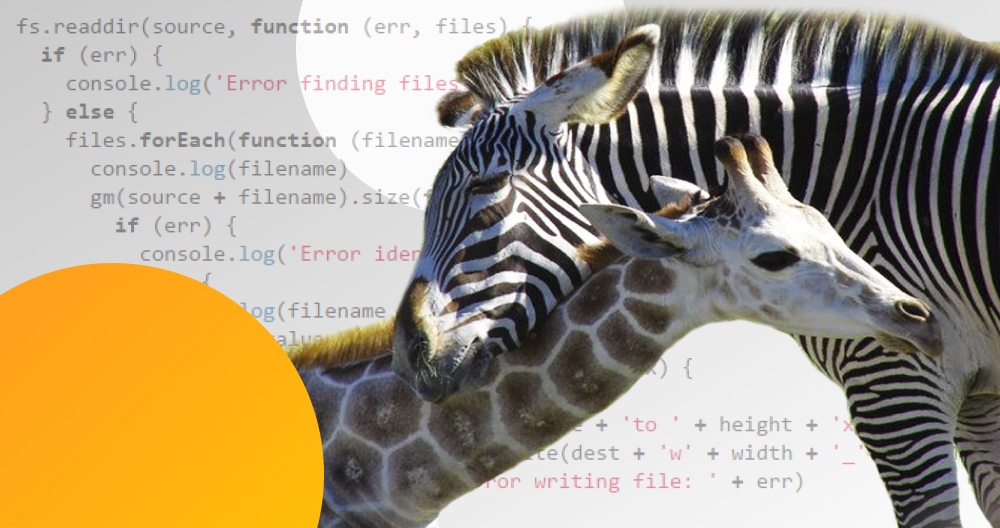NodeJS vs Golang? What a pretty controversial comparison that is, don't you think so? These two beasts are two different development tools. They belong to different classes of technology — a runtime environment and a programming language, respectively. But people on the Internet keep asking “What’s the difference?”. And we are no exception. So, this article is the Node.JS vs Golang comparison (however weird it may sound to the tech community).
written by:
Anton Rykov
Product Manager
NodeJS vs Golang is a pretty controversial comparison, as those two are two different development tools. They belong to different classes of technology - a programming language and runtime environment, respectively. But people on the Internet keep asking “What’s the difference?”. So, this article is the Node.JS vs Golang comparison (however weird it may sound to the tech community).
Contents
Node.JS vs. Golang: What Is What?
What Is Golang
Go is a statically typed, compiled (Go's runtime does not include a virtual machine), garbage-collected, open-source programming language which comes from the C family of programming languages. It is mainly used for backend development.
It’s extremely fast (Go apps compile to native machine code) and efficient, as it was based on the C language, which is the most efficient programming language so far.
A steep learning curve is definitely not something that Go developers have to worry about. Golang doesn't make its users apply any strict object-oriented design structures. There are no classes, and the language has just 25 keywords. In other words, Go's syntax is more than user-friendly. It possesses high clarity and is easy to read. For developers, this is a very good thing: they can understand code written by somebody else without any difficulty. In the long run, when developers switch projects, system maintenance won't be a problem.
Despite being seemingly simple, Golang was designed to resolve big challenges of the big company. It’s well known for its concurrency support for multicore machines running web servers with multiple clients, which was Go’s answer to the modern-day tech realia. Concurrency was and is one of Golang’s killer features. Check out Go's lightweight threads called goroutines to see how beautifully concurrency is dealt with in Golang.
Easy grammar equals easy-to-write tooling, as Rob Pike states in his brilliant article on Go. So yeah, that proved to be true and the Go programming language is definitely known for its tremendous tooling (like Gofmt and others). Read this great piece to learn more about those tools.
Garbage collection and error handling, on the contrary, do confuse many developers, but Rob Pike tried his best to explain why those features are used in Go (see the article above).
How the Go Programming Language Appeared
The Go language was created in Google around 2008-2009 to mainly help the tech giant deal with their specific issues of that time. Among those issues were multicore machines, networking, and web app development. According to Golang creators (Ken Thompson, Robert Griesemer, and Rob Pike), the old languages like C, Java and Python bypassed those modern-day challenges, rather than tackled them. Thus, they came up with a new solution tailored to those specific business needs.
Additionally, the programming languages listed above have quite a high learning curve, thus there was a request for a simpler language that could still solve the main challenges while working with the company’s intricate systems. More specifically, the challenges were the slowness and clumsiness of software development that didn’t enable for the process efficiency and scalability. On top of that, the majority of Google’s employees are young people with contrasting backgrounds. Often those differences could negatively affect the product they deliver as a team.
A simple language easy to understand and write was to unite the talents and help them overcome that barrier. To enable this, every Google employee now uses code that is simple to write and read. This results in clearer code, higher system reliability and easier maintainability.
Thus, the Go programming language appeared to deal with specific tech challenges of its time and to help Google’s developers act as a single whole.
What Golang Is Used For
Golang is mainly a server-side language (used for backend development), although its application area is growing tremendously. Some companies are using it even for front-end development, but that isn’t kind of mainstream for now.
So, what Golang is mainly used for?
As it was created to deal with the modern-day tech challenges, it shows itself best in the following areas:
- network programming,
- big data,
- cloud computing
- machine learning,
- geofence,
- microservices,
- audio and video streaming and editing.
Let’s have a brief overview of the companies using Golang.
A tech giant and the father of Golang uses it but keeps its application areas confidential. Yet, it did share that it uses it for Youtube and dl.google.com.
Dailymotion
This video streaming platform uses Golang to deal with APIs automation issues.
Dropbox
A cloud computing giant tackles scalability issues with Golang. Most of its infrastructure is written in Go.
Hewlett-Packard
HP is actively using Go in its software and hardware to support the simultaneous execution of threads and processes by means of structuring a program.
Netflix
The video streaming platform uses Golang for its Rend proxy. See the details in its Technology Blog.
IBM
IBM is another big Go advocate and has created a wide network of products to support its Go clients.
So, Golang is a server-side statically typed open-source popular programming language widely recognized for its high performance. It’s also a compiled language well known for its allocated memory management (using garbage collector) and concurrent programming capabilities. It has a huge fan club with the number of Go developers constantly growing.
Time to get to know Node.JS!
What Is Node.JS
Node JS isn't another popular programming language. It's an open-source cross-platform runtime environment for executing JavaScript code.
As simple as that.
Node JS is often used to build back-end services (also known as APIs). Those APIs power client applications, be it a web app, mobile ora desktop appl.
Some other things that make Node JS popular include:
- easy learning curve
- allows building fast and highly scalable applications
- uses JS (which is super easy and beginner-friendly; actually, JavaScript front-end developers can become full-stack developers now thanks to NodeJS)
- Great for fast prototyping
- Open-source libraries in abundance.
Sounds cool, doesn’t it?
Definitely. How did the IT guys come up with such a great thing? Read on!
How Node JS Appeared
The history of Node JS starts with JavaScript, one of the most beloved programming languages among developers of all time. Easy to learn, interactive, great community, and what’s not. But it’s not a Go vs JavaScript article, so back to business.
JS was created in 1995 and at that time it was used solely for web development purposes. But definitely using it solely as a client-side scripting programming language would be impractical. While other languages used at that time - such as Python, C, C++, etc. - were used both on the machine side and on the client side, JavaScript continued as a browser language. What a shame for the software development world!
But it could not last forever. One day a guy named Brendan Eich solved the problem. He actually developed JavaScript and JS compiler (both in 10 days!).
As a browser language, JS has to be converted into a machine code so that the machine can understand it. The converting thing is performed by the JavaScript engine, which is a unique thing for every browser. Unsurprisingly, the first JS engine was developed by Brendan Eich for Netscape Communication. Later on, other engines appeared - Google Chrome, Mozilla Firefox, Safari, Microsoft Edge, and others all came to develop their own engines. And it is here where the story of Node JS begins.
Google Chrome was the best with its V8 JavaScript engine. It was the fastest and did the converting job just right and soon became the most popular JavaScript engine. As converting JS was now a piece of cake the software development community thought - hey, why not use JS elsewhere outside the browser?
So that you could understand what’s going on here, we’ve made a picture for you.
Basically, to make JS run outside the browser, the developers had to replicate the architecture that you see in the picture above and add some new components.
In 2009, Ryan Dahl came up with a brilliant idea: he took Chrome's V8 engine and embedded it inside a C++ program. The resulting thing saw the light under the name of Node. Thus Node JS was born!
So, similar to Chrome browser, Node JS executes JavaScript code but this time outside of a browser. They share the same engine but have different runtime environments. The Node JS environment is suitable for executing JS on the machine side, it has some new modules that give JavaScript new capabilities for mobile, desktop, and server-side applications.
Thus Node JS made it possible for the development community to use their favorite JS not only for interactive web development but for many other purposes!
What Node JS Is Used For
Node.JS is a perfect match for highly scalable, data-intensive, and real-life applications. This is due to the non-blocking asynchronous nature of NodeJS. What does it mean?
In NodeJS a single threat is allocated to service multiple requests.
When a request arrives, a single threat is used to handle it. If we need to refer to a database to fetch a response, a threat doesn’t wait for a database to respond. Rather it proceeds with other requests and when a database is ready with the data, it puts it in the event queue. The queue is constantly monitored by NodeJS, and thus the clients are served with the necessary data continuously.
Such an event-driven architecture (callback mechanism) of NodeJS makes it perfect for processing hundreds of thousands of simultaneous requests. You must be very well familiar with the applications that use NodeJS. One of them is Google Docs and Spreadsheets.
Cool, what else?
- SPAs
- Browser games (with Chat rooms)
- Data streaming apps.
What companies use Node.JS? Despite the fact that the tool is relatively new to the developers' world, plenty of Fortune 500 enterprises opt for this framework for good reason.
The biggest names among them are:
- PayPal
- NASA
- eBay
- Netflix
- Uber
- Trello
- Yahoo
- Uber.
Hence, NodeJS is a runtime environment that allows executing JS outside the browser. In other words, it made using JS on the server-side possible. Due to the non-blocking asynchronous algorithms of work, NodeJS is ideal for data-intensive (or I/O intensive) applications, or apps with high scalability demands and applications that require high life performance.
NodeJS vs Golang: Let’s Sum It Up
So, now you're equipped with the knowledge to properly compare Node.JS vs Golang.
Actually, it’s a little bit weird, as Node.JS and Golang are different development tools, as we’ve mentioned earlier. Node.js vs Golang comparison is a wrong thing de-facto as you can't compare a spoon to a cooker!
Golang is a statically typed garbage-collected programming language enabling high performance, while NodeJS is a cross-platform runtime environment (not a language or a framework). So to say, while Go functions by itself, NodeJS actually helps JavaScript to function as a server-side language.
They are both used globally as acknowledged pieces of technology. Both have a great community and an army of fans (among which are such big names as Google, Netflix, Youtube, PayPal, etc.). One more thing in common - they are both used mainly for backend development.
At the same time, Node.JS and Golang definitely can’t be compared and one isn’t better or worse than the other. All in all, it’s absolutely wrong to mark development tools with a GOOD or BAD label, as every technology is developed with a purpose. And if at some point it acts ‘worse’ than another tool, maybe it simply wasn’t designed to be used that way?
We hope you’ve enjoyed this article. Find more great articles about modern technologies - programming languages, frameworks, APIs, etc. - on our blog. Qulix is a mature software development company with tons of experience in web development using modern-age and well-tested and tried tools.

Contacts
Feel free to get in touch with us! Use this contact form for an ASAP response.
Call us at +44 151 528 8015
E-mail us at request@qulix.com














